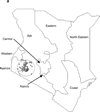Frequent occurrence of esophageal cancer in young people in western Kenya
- PMID: 19473205
- PMCID: PMC3505035
- DOI: 10.1111/j.1442-2050.2009.00977.x
Frequent occurrence of esophageal cancer in young people in western Kenya
Abstract
Esophageal cancer has a strikingly uneven geographical distribution, resulting in focal endemic areas in several countries. One such endemic area is in western Kenya. We conducted a retrospective review of all pathology-confirmed malignancies diagnosed at Tenwek Hospital, Bomet District, between January 1999 and September 2007. Tumor site, histology, sex, age, ethnicity, and location of residence were recorded. Cases were analyzed within and outside a traditional catchment area defined as < or = 50 km from the hospital. Since 1999, the five most common cancer sites were the esophagus, stomach, prostate, colorectum, and cervix. Esophageal cancer accounted for 914 (34.6%) of the 2643 newly diagnosed cancers and showed increasing trends within and outside the catchment area. Fifty-eight (6.3%) patients were < or = 30 years old and 9 (1%) were < or = 20 years old; the youngest patient was 14 years at diagnosis. Young cases (< or = 30) were more common among patients of Kalenjin ethnicity (9.2%) than among other ethnicities (1.7%) (odds ratio [95% confidence interval] 5.7 [2.1-15.1]). This area of western Kenya is a high-risk region for esophageal cancer and appears unique in its large proportion of young patients. Our findings support the need for further study of both environmental and genetic risk factors for esophageal cancer in this area.
Figures





References
-
- Parkin DM, Bray F, Ferlay J, Pisani P. Global cancer statistics, 2002. CA Cancer J Clin. 2005;55:74–108. - PubMed
-
- Pisani P, Parkin DM, Bray F, Ferlay J. Estimates of the worldwide mortality from 25 cancers in 1990. Int J Cancer. 1999;83:18–29. - PubMed
-
- Abratt RP, Vorobiof DA. Cancer in Africa. Lancet Oncol. 2003;4:394–396. - PubMed
-
- Parkin DM, Ferlay J, Hamdi-Cherif M, et al. IARC Scientific Publications No. 153. Lyon: IARCPress; 2003. Cancer in Africa: Epidemiology and prevention. - PubMed
-
- Harding R, Higginson IJ. Palliative care in sub-Saharan Africa. Lancet. 2005;365:1971–1977. - PubMed
Publication types
MeSH terms
Grants and funding
LinkOut - more resources
Full Text Sources
Medical

